Yoga using props
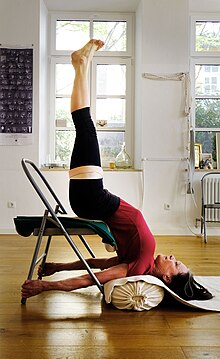
Props used in yoga include chairs,
One prop, the yoga strap, has an ancient history, being depicted in temple sculptures and described in manuscripts from ancient and medieval times; it was used in Sopasrayasana, also called Yogapattasana, a seated
History
The yogapaṭṭa in sculpture
The practice of
- In sculpture
-
Yogi (top right) using a strap, in relief sculpture of theGreat Stupa of Sanchi, c. 50 BCE to 50 CE
-
Yogi (centre) using strap around waist and legs,MahabalipuramCaves, c. 7th century
The sopāśraya asana
Textual evidence begins with the ancient bhāṣya commentary to the
- In illustrations
-
Painting of Nath yogis onGorkhatri. One yogi is using a strap to support his pose. 1590-1593
-
Sitting with a strap. Chawand, Rajasthan, 1605
-
yogapaṭṭāsana, "posture with yoga strap", in Sritattvanidhi, 19th century
The stambha meditation crutch
-
Stambha meditation crutch in use by a yogi at the Kumbh Mela, Haridwar, in 2010. Detail of photograph by James Mallinson[6]
Modern practice
For correct alignment
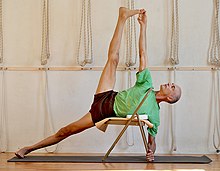
Chairs and other props are used widely in some schools of modern yoga as exercise. The use of props was pioneered in
For example, in Iyengar Yoga, Sarvangasana, shoulder stand, can be practised under suitable supervision with the shoulders on a bolster, the buttocks supported on the seat of a chair and a blanket, and the legs resting on the top of the chair's back.[7]
For ease in practice
The founder of the OM Yoga Center,
For Yin Yoga

The teacher of
To go deeper into a pose
The leading Iyengar yoga teacher Dean Lerner, in Yoga Journal, stated that the benefits of props depend on the experience, maturity, and ability of the practitioner; a mature student can enable "refined penetration into the pose and one's being".[14] Students may be afraid, he notes, of an inverted pose such as Shirshasana (yoga headstand); by practising against a wall, the student can learn to master the fear of falling, and can then continue practising there to develop stability, right alignment, and refined balance.[14] He adds that props can also be used to enable poses to be held for a longer duration, developing stability of mind and body, as well as poise and concentration; these, he states, enable the mind to draw inward and develop objectivity and humility, a step on the journey towards the Self.[14]
To prevent slipping
The yoga mat has become ubiquitous in the practice of yoga as exercise, to the extent that it may not even be thought of as a prop.[15] Its main function is "stickiness",[16] to prevent slipping, though it also provides a more comfortable surface such as for kneeling poses.[16] The mat may equally mark out a territory in a crowded class, or create a ritual space as it is unrolled to begin a session and rolled up at the end.[17][18]
When movement is restricted
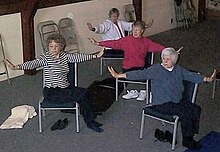
Alice Christensen's Easy Does It Yoga, first described in 1979, uses "chair exercises", alongside others on floor or bed, and in later editions also in swimming pools, for older practitioners with restricted movement.[19][20] Lakshmi Voelker-Binder created an approach named Chair Yoga in 1982, on seeing that one of her pupils, aged only in her thirties, was unable to do floor poses because of arthritis.[21][22]
Yoga as therapy is the use of asanas as a gentle form of exercise and relaxation, applied specifically with the intention of improving health. This may involve meditation, imagery, breath work (pranayama) and music alongside the exercise.[23] A 2013 systematic review found beneficial effects of yoga on low back pain.[24]
For aerial yoga
A specialised hammock consisting of support chains, a webbing strap, a silk hammock and carabiners is required for the yoga hybrid called Aerial yoga.[25]
See also
References
- ^ "Das Studio" (in German). Yogashala Munchen. Archived from the original on 25 July 2021. Retrieved 25 July 2021.
- ^ a b c Powell, Seth (June 2018). "The Ancient Yoga Strap". The Luminescent. Retrieved 20 June 2021.
- ^ The commentary is on Yoga Sutra 2.46, that an asana should be steady and comfortable.
- ]
- ^ OCLC 1077772000.
- ^ a b c Mallinson, James (2020). "Yogi Insignia in Mughal Painting and Avadhi Romances". In Orsini, Francesca; Lunn, David (eds.). To be published in: Objects, Images, Stories: Simon Digby's historical method (PDF). Oxford: Oxford University Press.
- ^ ISBN 978-0863184208.
- ISBN 978-0863184208.
- ^ Goldberg, Michelle (23 August 2014). "Iyengar and the Invention of Yoga". The New Yorker. Retrieved 20 November 2018.
- ^ ISBN 978-0-19-934037-8. Retrieved 20 March 2019.
- ^ Peters, Leslie (December 2006). "Proper Props". Yoga Journal (December 2006): 119–122. Retrieved 25 July 2021.
- ^ a b c Lee, Cyndi (2004). Yoga Body, Buddha Mind. Riverhead Books. pp. 145–146.
- ^ Clark, Bernie (7 January 2015). "The Why, What & How Behind Using Yoga Props". Elephant Journal. Retrieved 18 April 2021.
- ^ a b c Lerner, Dean (28 August 2007). "The Nature and Use of Yoga Props". Yoga Journal. Retrieved 18 April 2021.
- ^ Upham, Becky (10 September 2019). "Yoga Mats, Straps, Bolsters, and Other Props to Aid Your Practice". Everyday Health. Retrieved 25 July 2021.
Medically Reviewed by Lynn Grieger, RDN CDCES
- ^ a b YJ Editors (12 April 2017). "Test Your Mat Savvy: 5 Teachers' Favorite Yoga Mats". Yoga Journal. Retrieved 9 May 2019.
- Jain, Andrea (14 August 2015). "Five myths about yoga". The Washington Post.
- ^ Korpelainen, Noora-Helena (2019). "Sparks of Yoga: Reconsidering the Aesthetic in Modern Postural Yoga". Journal of Somaesthetics. 5 (1): 46–60.
- Harper and Row; Light of Yoga Society.
- OCLC 41951264.
- ^ "About Lakshmi Voelker". Get Fit Where You Sit. Archived from the original on 10 March 2021. Retrieved 8 April 2019.
- OCLC 1134762765.
- ^ Feuerstein, Georg (2006). Jonathan Shear (ed.). The Experience of Meditation. St. Paul, Minnesota: Paragon House. p. 90.
- S2CID 12547406.
- howstuffworks. Retrieved 25 July 2020.

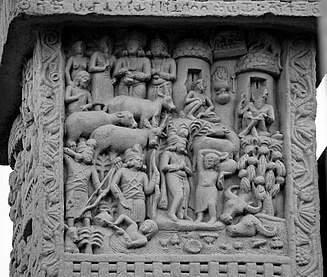
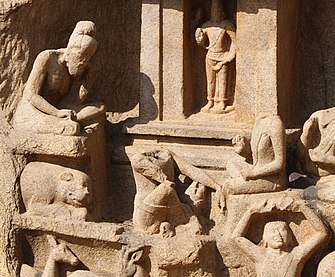




![Stambha meditation crutch in use by a yogi at the Kumbh Mela, Haridwar, in 2010. Detail of photograph by James Mallinson[6]](http://upload.wikimedia.org/wikipedia/en/thumb/c/c8/Stambha_meditation_crutch_Haridwar_2010.jpg/258px-Stambha_meditation_crutch_Haridwar_2010.jpg)
